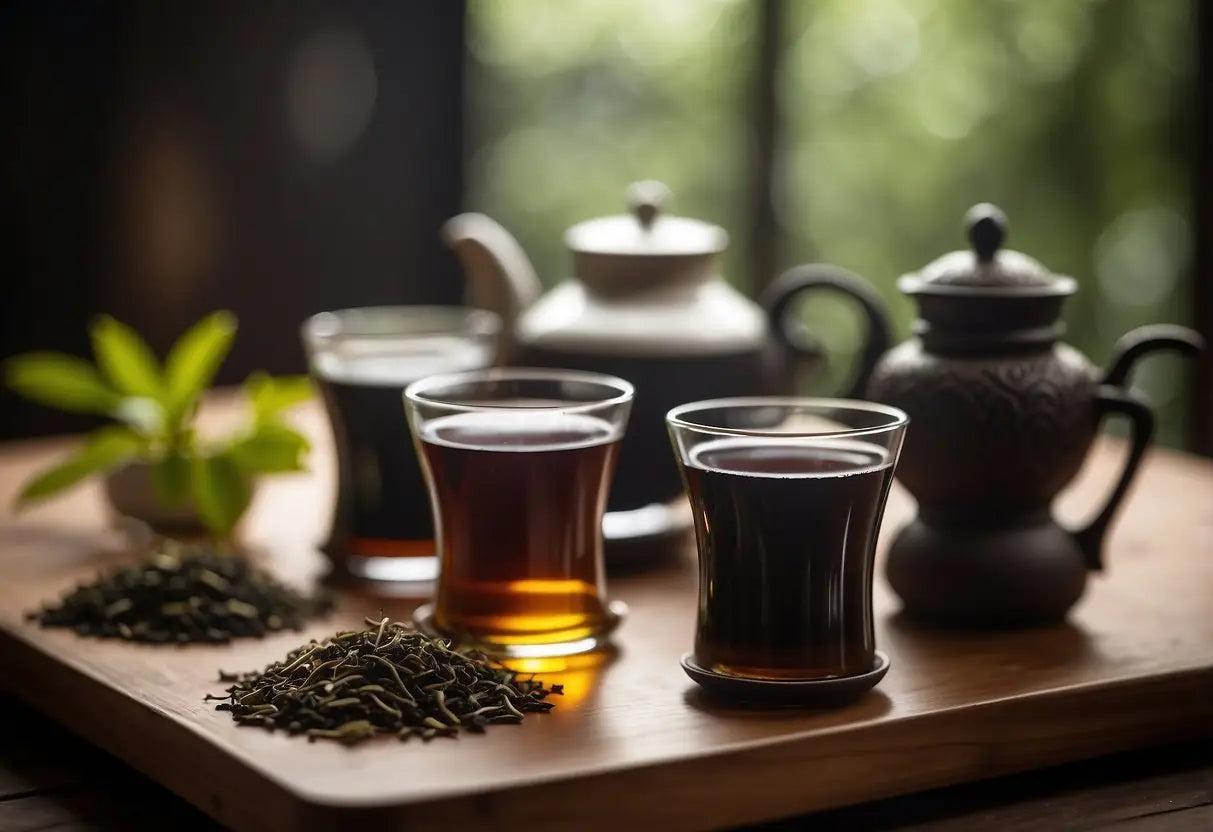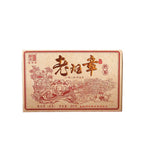Pu Erh vs Black Tea
Shop our Pu Erh Tea collections!
Pu-erh tea is a unique type of fermented tea that originates from Yunnan province in China. It stands out due to its fermentation and aging process.
There are two main types: Raw (Sheng) Pu-erh and Ripe (Shou) Pu-erh. Raw Pu-erh undergoes natural aging, while Ripe Pu-erh is fermented with a more controlled process.
Bestsellers

2022 Pu-Erh Tea Sample Box (Free Shipping)

2022 Yi Pin Chen Sheng Raw Pu-erh Tea Sample Box

2022 Lao Ban Zhang Raw Pu-erh Tea

2022 Na Ka Raw Pu-erh Tea

2023 Ban Zhang Yin Xiang Raw Pu-erh Tea

2017 Rong Pu Ripe Pu-erh Tea
Both types develop a rich, deep flavor profile over time.
Pu-erh is typically pressed into cakes, bricks, or loose-leaf forms. This tea is often aged for years, enhancing its taste and value.
Common aromas include earthy, woody, and sometimes sweet notes.
Discover our best-selling raw Pu Erh tea and elevate your tea experience today!
Health Benefits:
- Aids in digestion
- May support cardiovascular health
- Contains antioxidants
Brewing Recommendations:
- Water Temperature: 95-100°C (203-212°F)
- Steep Time: 3-5 minutes
- Leaf Amount: 1-2 teaspoons per cup
Pu-erh can be brewed multiple times, with each steep revealing new flavors.
Enjoying Pu-erh tea is often seen as a journey due to its evolving taste and complexity.
Overview of Black Tea

Black tea is a fully oxidized tea, giving it a dark color and rich flavor. It is one of the most popular types of tea worldwide.
Key characteristics of black tea include:
- Oxidation Level: Fully oxidized.
- Flavor Profile: Rich, bold, and often malty.
- Caffeine Content: Higher than green or white tea.
Notable Varieties
Several varieties of black tea are popular:
Lao Ban Zhang

2024 Lao Ban Zhang Ripe Pu-erh Tea

2022 Lao Ban Zhang Raw Pu-erh Tea

2023 Ding Feng- Lao Ban Zhang Raw Pu-erh Tea (42g)

2024 Xiao Ban Zhang Raw Pu-erh Tea

2020 Lao Ban Zhang Raw Pu-erh Tea 125g

2025 Lao Ban Zhang -Gan En Raw Pu-erh Tea 357g
- Assam: Known for its strong, malty flavor.
- Darjeeling: Light and floral with hints of muscatel.
- Ceylon: Bright and brisk, often with citrus notes.
Health Benefits
Black tea is rich in antioxidants, which are linked to various health benefits:
- Improved heart health
- Enhanced mental alertness
- Antioxidant properties
Brewing Tips
To get the best flavor from black tea, consider these tips:
- Water Temperature: 90-95°C (194-203°F)
- Steep Time: 3-5 minutes
- Tea-to-Water Ratio: 1 teaspoon per cup
Enjoy black tea plain or with milk and sugar, based on your preference.
Historical Origins and Cultural Significance

Pu-erh tea and black tea both have rich histories and hold special places in various cultures. They developed in different regions and have unique cultural impacts on those societies.
Historical Origins of Pu-erh Tea
Pu-erh tea originates from Yunnan province in China, boasting a history of over 1,700 years. It was historically a prized tribute tea during the Han Dynasty (206 BCE – 220 CE). By the Tang Dynasty (618-907 CE), it became an essential element in the trade along the ancient Tea Horse Road.
The cultivation of Pu-erh involves traditional methods that have been passed down through generations. These methods include sun-drying and fermenting, which contribute to the tea's unique qualities. The town of Pu'er, from which the tea gets its name, has been the central hub of Pu-erh tea production for centuries.
Historical Origins of Black Tea
Black tea traces its roots back to the late Ming Dynasty (1368–1644) in China. The first black tea, known as Lapsang Souchong, was produced in the Wuyi Mountains of Fujian province. The tea gained popularity when Chinese traders introduced it to European markets, leading to a burgeoning demand in the West.
The British played a crucial role in the spread of black tea. In the 19th century, they began large-scale cultivation in Assam and Darjeeling, India, and later in Sri Lanka (then Ceylon). These regions are now world-renowned for their high-quality black teas.
Cultural Significance of Pu-erh Tea
Pu-erh tea is deeply embedded in Chinese culture, particularly in Yunnan province. It is often consumed during traditional ceremonies and special occasions. The tea is believed to have medicinal properties, such as aiding digestion and reducing cholesterol, which has contributed to its revered status.
Aged Pu-erh is considered a valuable collectible. Connoisseurs often compare high-quality Pu-erh to fine wines, recognizing the complexity and depth of its flavor profile. The cultural rituals surrounding its preparation and consumption enhance its significance.
Cultural Significance of Black Tea
Black tea holds a prominent place in many cultures worldwide. In China, it's traditionally served during ceremonies and gatherings. In the UK, afternoon tea is a staple, reflecting centuries of cultural integration stemming from the colonial era.
In India, chai — a spiced tea blend made with black tea — is integral to daily life, symbolizing hospitality and warmth. Black tea also plays a significant role in Turkey, Russia, and Japan, each with unique preparation methods and customs.
Processing Techniques

Pu-erh and black tea undergo distinct processing techniques that shape their unique characteristics. Understanding these methods is essential for appreciating their flavors, health benefits, and culinary uses.
Flavor Profiles
Pu-erh tea undergoes fermentation and aging, resulting in rich, earthy flavors. Sheng (raw) Pu-erh develops a complex, vegetal taste with age, while Shou (ripe) Pu-erh has a smoother, darker profile.
Black tea, unlike Pu-erh, is fully oxidized. This oxidation imparts a robust, malty flavor. Varieties like Darjeeling offer delicate, floral notes, while Assam provides a stronger, maltier taste.
Health Benefits and Concerns
Pu-erh tea is known for its probiotic properties due to microbial fermentation. It may aid digestion and has potential benefits for cholesterol and weight management.
Black tea contains antioxidants like theaflavins and catechins, which support heart health and may reduce the risk of certain cancers. Both teas contain caffeine, so monitor your intake if you're sensitive to stimulants.
Brewing Methods
Brewing Pu-erh requires rinsing the leaves to remove impurities. Use boiling water and steep for 2-5 minutes. For traditional preparation, consider using a gaiwan or Yixing teapot.
Black tea is best brewed with water just off the boil (around 200-212°F). Steep for 3-5 minutes. Adjust the steeping time based on personal preference. Western-style brewing and Eastern-style methods offer different experiences.
Pairing and Culinary Uses

Pu-erh pairs well with rich, savory foods like mushrooms and dark chocolate due to its earthy tones. It can complement Chinese cuisine and is sometimes used in broths and marinades.
Black tea's versatility makes it suitable for both sweet and savory dishes. Pair it with pastries, fruits, cheeses, and even certain meats. Its robust flavor enhances sauces and desserts.
Varieties and Classifications
Pu-erh tea has two main types: Sheng (raw) and Shou (ripe). Each category has its own aging and fermentation process, contributing to different flavor profiles and aging potentials.
Black tea is classified by region and processing style. Assam and Darjeeling are notable Indian varieties, while Keemun and Lapsang Souchong represent distinct Chinese styles.
Storage and Aging
Proper storage is crucial for Pu-erh. Store it in a cool, dry place with adequate airflow. Avoid strong odors. Aging improves its flavor, making it more prized over time.
Black tea should be kept in airtight containers away from light, moisture, and strong odors. It doesn't improve with age like Pu-erh, so consume it within a year for optimal freshness.
Global Market and Trade
Pu-erh tea is primarily produced in Yunnan Province, China. Its market value increases with age and rarity. Global demand is growing, especially among connoisseurs.
Black tea is produced in various countries including China, India, Sri Lanka, and Kenya. It dominates the global market, making up the majority of tea consumed worldwide. The trade involves a wide range of grades and qualities.
← Older post Newer post →
